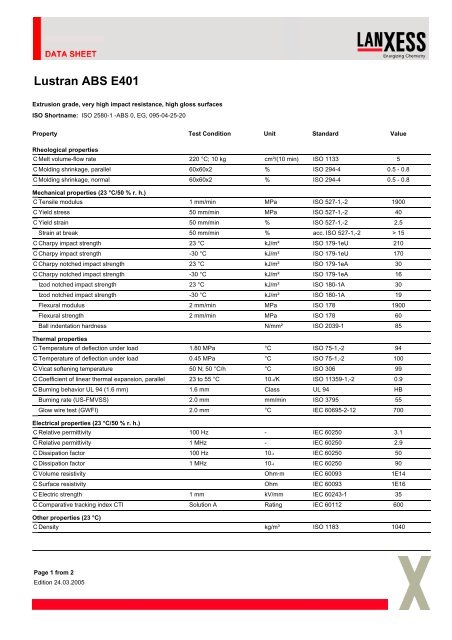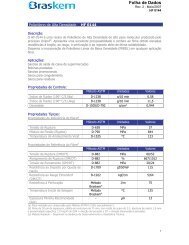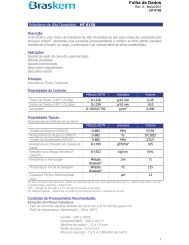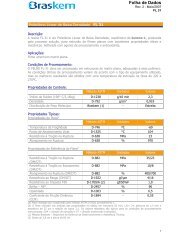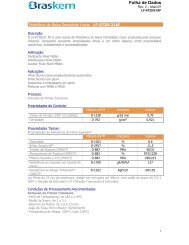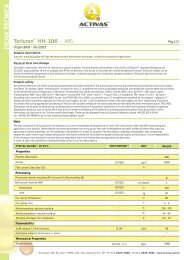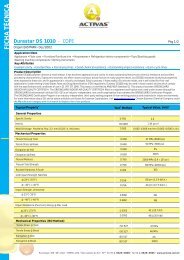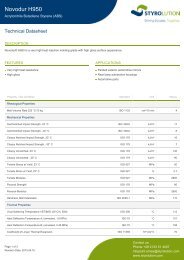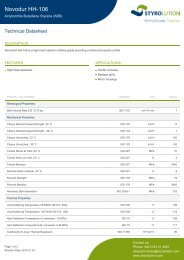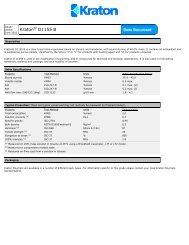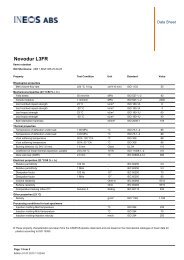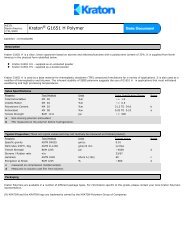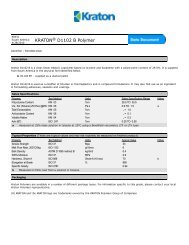Lustran ABS E401 - Activas
Lustran ABS E401 - Activas
Lustran ABS E401 - Activas
You also want an ePaper? Increase the reach of your titles
YUMPU automatically turns print PDFs into web optimized ePapers that Google loves.
<strong>Lustran</strong> <strong>ABS</strong> <strong>E401</strong>Extrusion grade, very high impact resistance, high gloss surfacesISO Shortname: ISO 2580-1 -<strong>ABS</strong> 0, EG, 095-04-25-20Property Test Condition Unit Standard ValueRheological propertiesC Melt volume-flow rate 220 °C; 10 kg cm³/(10 min) ISO 1133 5C Molding shrinkage, parallel 60x60x2 % ISO 294-4 0.5 - 0.8C Molding shrinkage, normal 60x60x2 % ISO 294-4 0.5 - 0.8Mechanical properties (23 °C/50 % r. h.)C Tensile modulus 1 mm/min MPa ISO 527-1,-2 1900C Yield stress 50 mm/min MPa ISO 527-1,-2 40C Yield strain 50 mm/min % ISO 527-1,-2 2.5Strain at break 50 mm/min % acc. ISO 527-1,-2 > 15C Charpy impact strength 23 °C kJ/m² ISO 179-1eU 210C Charpy impact strength -30 °C kJ/m² ISO 179-1eU 170C Charpy notched impact strength 23 °C kJ/m² ISO 179-1eA 30C Charpy notched impact strength -30 °C kJ/m² ISO 179-1eA 16Izod notched impact strength 23 °C kJ/m² ISO 180-1A 30Izod notched impact strength -30 °C kJ/m² ISO 180-1A 19Flexural modulus 2 mm/min MPa ISO 178 1900Flexural strength 2 mm/min MPa ISO 178 60Ball indentation hardness N/mm² ISO 2039-1 85Thermal propertiesC Temperature of deflection under load 1.80 MPa °C ISO 75-1,-2 94C Temperature of deflection under load 0.45 MPa °C ISO 75-1,-2 100C Vicat softening temperature 50 N; 50 °C/h °C ISO 306 99C Coefficient of linear thermal expansion, parallel 23 to 55 °C 10-4/K ISO 11359-1,-2 0.9C Burning behavior UL 94 (1.6 mm) 1.6 mm Class UL 94 HBBurning rate (US-FMVSS) 2.0 mm mm/min ISO 3795 55Glow wire test (GWFI) 2.0 mm °C IEC 60695-2-12 700Electrical properties (23 °C/50 % r. h.)C Relative permittivity 100 Hz - IEC 60250 3.1C Relative permittivity 1 MHz - IEC 60250 2.9C Dissipation factor 100 Hz 10-4 IEC 60250 50C Dissipation factor 1 MHz 10-4 IEC 60250 90C Volume resistivity Ohm·m IEC 60093 1E14C Surface resistivity Ohm IEC 60093 1E16C Electric strength 1 mm kV/mm IEC 60243-1 35C Comparative tracking index CTI Solution A Rating IEC 60112 600Other properties (23 °C)C Density kg/m³ ISO 1183 1040Page 1 from 2Edition 24.03.2005
<strong>Lustran</strong> <strong>ABS</strong> <strong>E401</strong>Property Test Condition Unit Standard ValueProcessing conditions for test specimensC Injection molding-Melt temperature °C ISO 294 240C Injection molding-Mold temperature °C ISO 294 70C Injection molding-Injection velocity mm/s ISO 294 240C These property characteristics are taken from the CAMPUS plastics data bank and are based on the international catalogue of basic data forplastics according to ISO 10350.DisclaimerDisclaimer for sales productsThis information and our technical advice - whether verbal, in writing or by way of trials - are given in good faith but without warranty, and this also applies whereproprietary rights of third parties are involved. Our advice does not release you from the obligation to verify the information currently provided - especially that containedin our safety data and technical information sheets - and to test our products as to their suitability for the intended processes and uses. The application, use andprocessing of our products and the products manufactured by you on the basis of our technical advice are beyond our control and, therefore, entirely your ownresponsibility. Our products are sold and our advisory service is given in accordance with the current version of our General Conditions of Sale and Delivery.Test values styrenicsUnless specified to the contrary, the values given have been established on standardised test specimens at room temperature. The figures should be regarded as guidevalues only and not as binding minimum values. Kindly note that, under certain conditions, the properties can be affected to a considerable extent by the design of themould/die, the processing conditions and the colouring. This is valid especially for CTI.Processing noteUnder the recommended processing conditions small quantities of decomposition product may be given off during processing. To preclude any risk to the health andwell-being of the machine operatives, tolerance limits for the work environment must be ensured by the provision of efficient exhaust ventilation and fresh air at theworkplace in accordance with the Safety Data Sheet. In order to prevent the partial decomposition of the polymer and the generation of volatile decomposition products,the prescribed processing temperatures should not be substantially exceeded. Since excessively high temperatures are generally the result of operator error or defects inthe heating system, special care and controls are essential in these areas.LANXESS DEUTSCHLAND GMBH | D - 51369 LEVERKUSEN© LANXESS Deutschland GmbHPage 2 from 2Edition 24.03.2005


